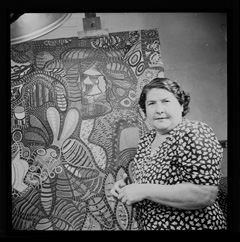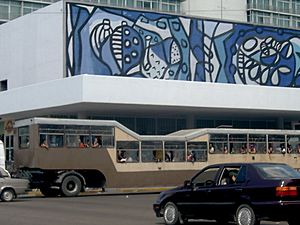Amelia Peláez facts for kids
Quick facts for kids
Amelia Peláez
|
|
|---|---|

Amelia Peláez
|
|
| Born | 1896 Yaguajay, Cuba
|
| Died | 8 April 1968 |
Amelia Peláez del Casal (born January 5, 1896 – died April 8, 1968) was a very important Cuban painter. She was part of the Avant-garde generation, which means she was one of the artists who created new and exciting styles of art.
Contents
Her Early Life and Studies
Amelia Peláez was born in 1896 in a town called Yaguajay. This was in a part of Cuba that is now called Sancti Spíritus Province. She was the fifth of eleven children in her family. Her family was part of the Cuban-Creole middle class.
Her father, Manuel Pelaez y Laredo, was a doctor. Her mother, Maria del Carmen del Casal y Lastra, took care of the children at home. Amelia's uncle was Julián del Casal, a famous poet. Because of him, her family was connected to many smart and artistic people in Cuba.
In 1917, when Amelia was 21, her family moved to Havana. This move gave her a chance to study art. She joined the Escuela Nacional de Bellas Artes "San Alejandro". Most students there started around age 12 or 13, so she began a bit later.
She was one of the favorite students of her teacher, Leopoldo Romañach. In 1924, she finished her studies at San Alejandro. She showed her paintings for the first time with another Cuban artist, María Pepa Lamarque. This exhibition was at the Association of Painters and Sculptors in Havana.
With a small government scholarship, Amelia traveled to New York City in 1924. She studied for six months at the Art Students League of New York. In 1927, she received a bigger scholarship. This allowed her to study in France. She also made short trips to Spain, Italy, and other countries.
Student Life in Paris
Amelia moved to Paris, France, with Cuban writer Lydia Cabrera. She had a government scholarship to study art there. Both of them took painting and art history classes at the École Nationale Supérieure des Beaux-Arts. Amelia also studied drawing and art history at the Académie de la Grande Chaumière and the École du Louvre.
In 1931, Amelia and Lydia joined the Academie Contemporaine to study with Fernand Léger. After that, Amelia began learning from the Russian painter Aleksandra Ekster. Their friendship and classes on color theory and design greatly influenced Amelia's art.
In 1933, Galerie Zak held a special show just for Amelia's paintings. She displayed 38 of her artworks there. That same year, she showed her work at the eleventh Salon des Tuileries. She also took part in an exhibition of illustrated books. In this show, she illustrated seven poems by Leon Paul Fargue. During her years in Paris, French art critics praised her work a lot.
Life in Havana
In 1934, after showing her art at the Salon Des Independants, Amelia returned to Cuba. She moved back into her mother’s old colonial-style house. When Amelia came back, Cuba was facing tough economic times and political problems.
Since the late 1920s, Cuba was looking for new art that showed its national identity. Amelia responded by changing her art style. She started painting Afro-Cuban people and guajiros (Cuban peasants). She combined these Cuban subjects with European modern art styles.
According to art expert Ingrid Williams Elliot, Amelia’s bright colors and thick lines came from Spanish-colonial buildings. She mixed everyday objects with building decorations. Peláez used "Baroque ornamentation" from old colonial homes in her art. She blended different styles and times to create a unique Cuban art style.
In 1935, Amelia had a solo exhibition at a women’s club in Havana called the Lyceum. This show helped people see and appreciate her new, modern Cuban art.
Around the mid-1930s, Peláez experimented with patterns and shapes. She used tablecloths and fruit dishes in her art. This helped her develop the geometric designs and rhythmic patterns seen in her later works. These patterns were often linked to architectural decorations. Her work also showed her understanding of Cubism, an art style that uses geometric shapes. Her famous still life paintings were praised for using native Cuban fruits and flowers. This showed her strong connection to her Cuban roots.
From 1935 to 1936, Peláez focused on drawings using ink and pencil. These drawings were different from her oil paintings. She would stretch and exaggerate figures with curvy lines and light shading. This style also showed influences from Cubism and European Modernism.
Peláez won an award at the National Exposition of Painters and Sculptors in 1938. She also worked with several art magazines in Cuba. These included Orígenes, Nadie Parecía, and Espuela de Plata. In 1950, she opened an art workshop in San Antonio de los Baños, a small city near Havana. There, she spent her time making pottery until 1962.
She sent her paintings to the São Paulo Art Biennial in 1951 and 1957. In 1952, she took part in the Venice Biennale. In 1958, she was a special guest and a judge at an art show in Mexico City. She left the judging because she felt the decisions were unfairly biased.
Besides painting and pottery, she also created murals. Many of these murals are in different schools in Cuba. Two of her most important murals are a ceramic mural at the Tribunal de Cuentas in Havana (1953) and the outside wall of the Habana Hilton hotel (1957). It was hard for her to sell her paintings while she was alive. She and her artworks, later called "Amelias," became famous much later in her life.
Amelia Peláez passed away in Havana in 1968.
Her Home: Estrada Palma 261
Amelia lived in her mother's house at Estrada Palma 261 for the rest of her life after returning to Havana. This house was a mix of old Greek-Roman style and traditional Cuban Creole architecture. After she returned and lived a more private life, her home became a major source of ideas for her art.
The house was built in 1912. It was filled with old-fashioned furniture in the Baroque style. Inside, the house had beautiful details made of marble, crystal, wood, and ceramics. Amelia also hung her own paintings as decorations in her home.
Exhibitions
- 1924 Amelia Pelaez y Maria Pepa Lamarque, Asociacion de Pintores y Escultores, Havana.
- 1933 Amelia Pelaez Del Casal, Galerie Zak, Paris.
- 1935 Amelia Pelaez Del Casal, Lyceum, Havana.
- 1941 Amelia Pelaez, Norte Gallery, New York.
- 1943 Amelia Pelaez: Retrospectiva, Institucion Hispano—Cubana de Cultura, Havana.
- 1956 Amelia Pelaez, Nuestro Tiempo, Havana.
- 1957 Amelia Pelaez, Lyceum, Havana.
- 1959 Pintura de Amelia Pelaez, Instituto Municipal de Cultura, Marianao, Havana.
- 1960 Amelia Pelaez.
- 1964 Oleos y Temperas de Amelia Pelaez, Galeria de la Habana, Havana.
- 1967 Dibujos de Amelia Pelaez, Museo de Arte Moderno Bogota. Amelia Pelaez; Goaches y Ceramicas, Lyceum, Havana.
- 1968 Amelia Pelaez: Exposicion Retrospectiva, Museo Nacional, Havana.
- 1977 Amelia Pelaez, Metropolitan Museum & Art Center, Miami.
- 1979 La Gran Pintora Cubana Amelia Pelaez, Museo de Arte Moderno, Mexico City.
- 1980 Amelia Pelaez, Museo de Arte Moderno, Bogota.
- 1987 Amelia Pelaez, Nineteenth Sao Paulo Biennial, Sao Paolo.
- 1988 Amelia Pelaez; A Retrospective, Cuban Museum of Arts & Culture, Miami.
Collections
You can find Amelia Peláez's artworks in important museums. These include the Museo Nacional de Bellas Artes de La Habana in Cuba and the Museum of Modern Art in New York.
See also
 In Spanish: Amelia Peláez para niños
In Spanish: Amelia Peláez para niños



